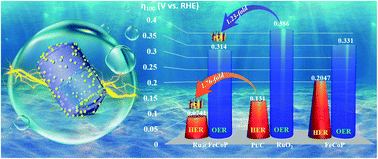Construction of Ru/FeCoP heterointerface to drive dual active site mechanism for efficient overall water splitting†
Abstract
The interface engineering strategy is deemed to be a direct approach for boosting the water splitting activity of materials, but it is still a challenge to achieve both hydrogen evolution reaction (HER) and oxygen evolution reaction (OER) activities exceeding those of precious-metal catalysts. Herein, a tunable photodeposition method was utilized for the construction of Ru@FeCoP with rich Ru/FeCoP heterointerfaces. Strikingly, the η100 value of Ru@FeCoP was only 0.0741 V for the HER and 0.314 V for OER, which was reduced by 63.8% and 55.2% compared to Pt/C and RuO2 benchmarks, respectively. The mechanism investigation revealed that Ru at the Ru/FeCoP heterointerfaces not only offers highly active sites for HER but also pulls electrons from FeCoP, which facilitates the generation of Fe and Co with high valency, thereby increasing the OER activity. This work overcomes the problem of low water-splitting efficiency of precious metals by constructing a metal/phosphide heterostructure to drive a dual-active site mechanism and provides an effective route for the preparation of high-performance water-dissociation electrocatalysts.



 Please wait while we load your content...
Please wait while we load your content...